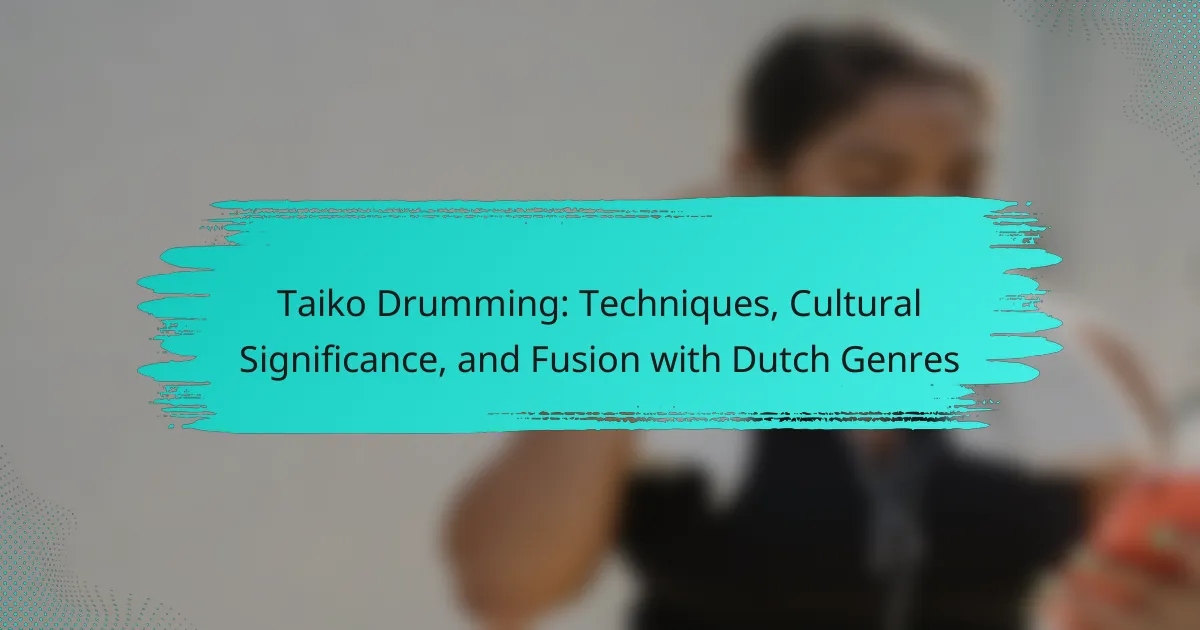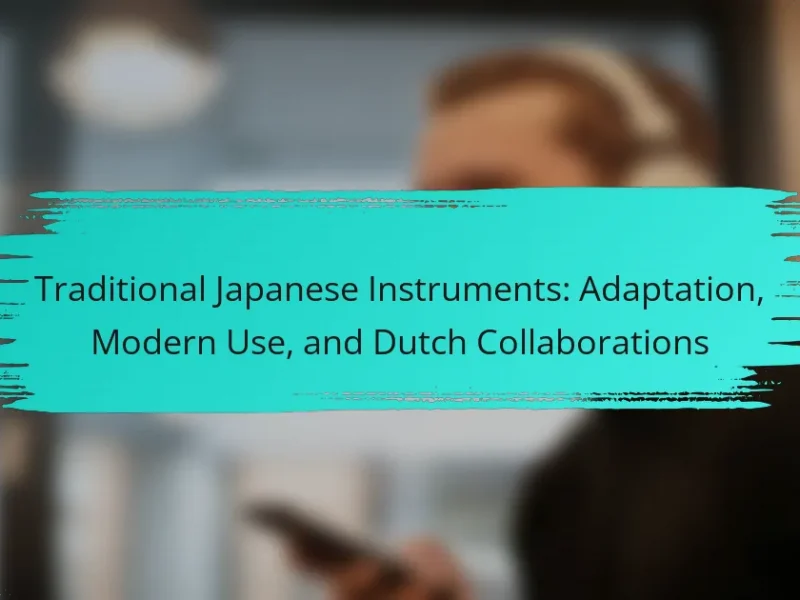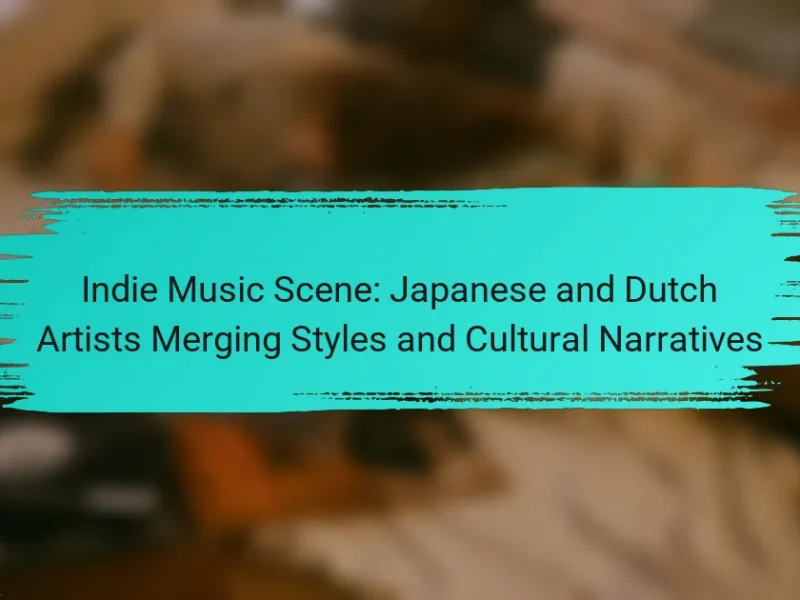Taiko drumming offers powerful rhythms and cultural depth, making it a compelling art form. This article explores essential techniques for mastering Taiko, its cultural significance in Japan, and its innovative fusion with Dutch music genres. Discover how these elements enhance both performance quality and community connection. Learn about the challenges faced in merging traditions and the resources available for aspiring drummers.
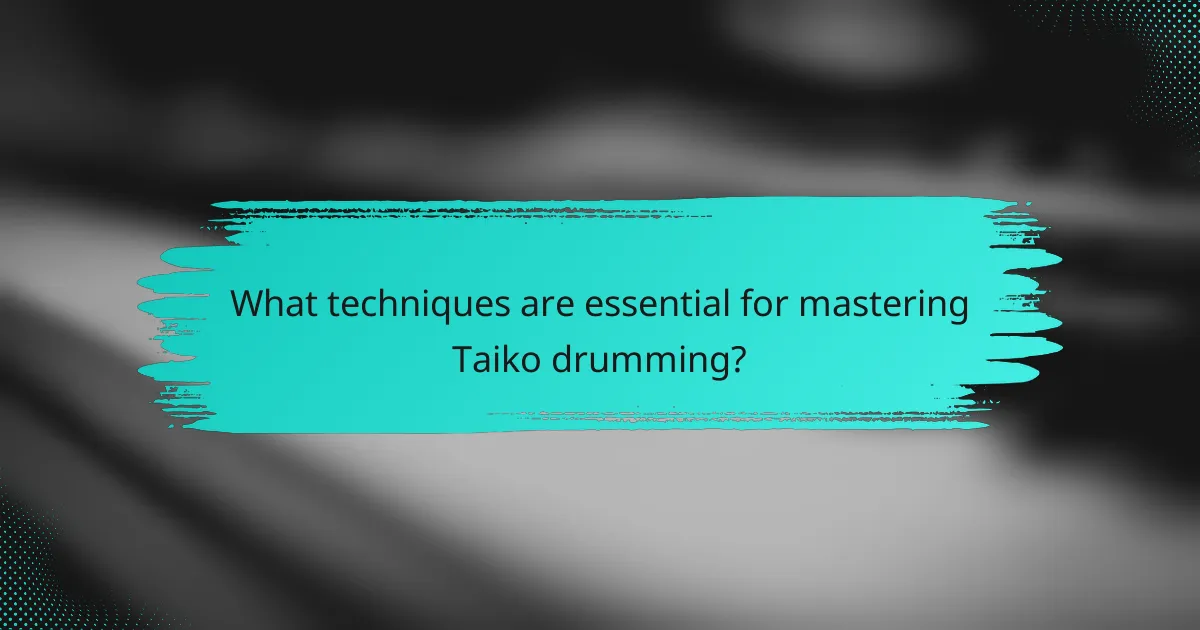
What techniques are essential for mastering Taiko drumming?
To master Taiko drumming, focus on techniques such as proper grip, posture, rhythm patterns, and dynamic control. These foundational skills enhance performance quality and cultural expression.
1. Proper Grip: Maintain a relaxed yet firm hold on the bachi (drumsticks) to facilitate fluid movement.
2. Posture: Stand with feet shoulder-width apart, knees slightly bent, and back straight to enable stability and power.
3. Rhythm Patterns: Practice traditional and contemporary rhythms to build timing and coordination.
4. Dynamic Control: Vary volume and intensity to convey emotion and engage the audience.
These techniques not only improve individual skill but also deepen the cultural significance of Taiko drumming.
How does body posture influence performance in Taiko drumming?
Body posture significantly influences performance in Taiko drumming by affecting energy transfer and rhythm execution. Proper posture enhances stability, allowing drummers to generate power and maintain endurance throughout performances. A straight back and engaged core enable optimal arm movement, crucial for striking the drum with precision. Additionally, correct posture reduces the risk of injury, ensuring longevity in practice and performance. The cultural significance of Taiko emphasizes the connection between physical presence and musical expression, making posture a vital element in both technique and tradition.
What role does rhythm play in Taiko drumming techniques?
Rhythm is fundamental in Taiko drumming techniques, driving the energy and dynamics of performances. It establishes a strong foundation for synchronization among drummers, enhancing the overall impact of the music. Precise rhythm allows for intricate patterns, showcasing both individual skill and group cohesion. Additionally, rhythm in Taiko reflects cultural narratives, connecting performers and audiences through shared experiences.
Which instruments are commonly used in Taiko ensembles?
Taiko ensembles commonly use various traditional Japanese drums, including the nagado-daiko, shime-daiko, and odaiko. These instruments vary in size and sound, contributing to the ensemble’s dynamic range. The nagado-daiko is large and provides deep tones, while the shime-daiko is smaller and offers higher pitches. The odaiko, known for its powerful resonance, is often featured in performances. Other instruments, such as the fue (flute) and various percussion instruments, may also accompany the drums to enhance the overall sound.

How does Taiko drumming reflect cultural significance in Japan?
Taiko drumming embodies deep cultural significance in Japan, reflecting community, spirituality, and tradition. It serves as a medium for storytelling and ritual, often performed during festivals and ceremonies. The rhythmic patterns symbolize harmony and connection among participants, fostering a sense of belonging. Unique attributes include its diverse styles and techniques, which vary by region, enhancing local identity. Taiko also adapts to contemporary music genres, illustrating its evolving role in Japanese culture.
What historical events have shaped the evolution of Taiko drumming?
Taiko drumming has evolved through significant historical events, including its origins in Japan as a tool for communication and ritual. The introduction of Taiko in festivals and military contexts further shaped its cultural significance. In the 20th century, Taiko became a symbol of Japanese identity, especially during the post-war period, leading to its fusion with various music genres, including Dutch influences. The globalization of Taiko has expanded its reach, allowing for innovative techniques and collaborations that continue to redefine its tradition.
How is Taiko drumming integrated into Japanese festivals and rituals?
Taiko drumming is integral to Japanese festivals and rituals, enhancing cultural expression and community bonding. It serves as a rhythmic backdrop for celebrations, marking seasonal changes and significant events. The energetic performances often involve elaborate choreography, fostering a sense of unity among participants and spectators. Unique attributes include the use of large drums, such as the odaiko, which can weigh over 400 kilograms, emphasizing the physicality and artistry of the craft. Festivals like Gion Matsuri in Kyoto showcase taiko as a symbol of cultural heritage, blending tradition with modern interpretations.
What are the educational benefits of learning Taiko drumming?
Learning Taiko drumming offers significant educational benefits, including enhanced physical coordination, cultural awareness, and teamwork skills.
Taiko drumming requires precise movements, improving motor skills and rhythm. It fosters a deep understanding of Japanese culture, promoting appreciation for diverse traditions. Additionally, participating in group performances cultivates collaboration and communication among learners.
These attributes contribute to a well-rounded educational experience, blending physical, cultural, and social learning.
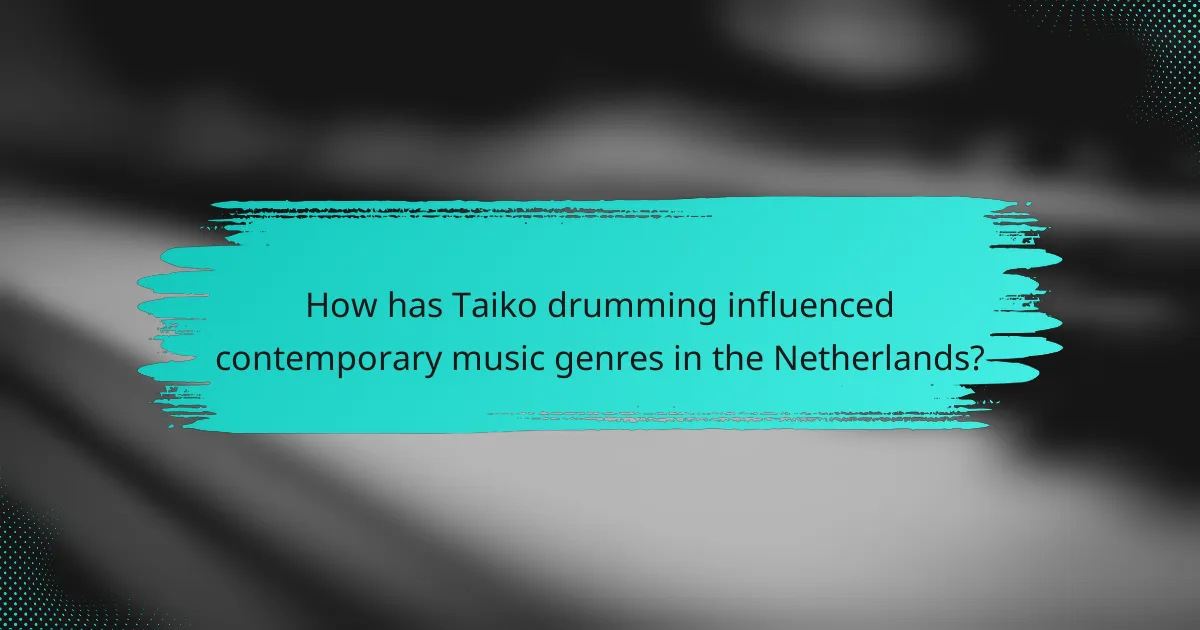
How has Taiko drumming influenced contemporary music genres in the Netherlands?
Taiko drumming has significantly influenced contemporary music genres in the Netherlands by introducing unique rhythmic patterns and cultural depth. This traditional Japanese art form has merged with Dutch genres like pop, jazz, and electronic music, enhancing their complexity and expressiveness.
Collaborations between Taiko ensembles and local musicians have led to innovative fusions, creating hybrid sounds that resonate with diverse audiences. For instance, the incorporation of Taiko rhythms into electronic tracks has resulted in a fresh auditory experience, appealing to younger generations.
Moreover, Taiko’s emphasis on community and performance has inspired collaborative music projects, fostering a sense of unity among artists. This cultural exchange enriches the Dutch music scene, making it more dynamic and globally connected.
The unique attributes of Taiko drumming, such as its powerful beats and communal spirit, continue to shape the evolution of contemporary music in the Netherlands, highlighting the importance of cross-cultural influences in artistic expression.
What fusion styles are emerging from Taiko and Dutch music traditions?
Emerging fusion styles from Taiko and Dutch music traditions blend rhythmic intensity with melodic elements. These styles incorporate Taiko’s powerful drumming techniques and Dutch folk melodies, creating unique soundscapes. Collaborations often showcase traditional instruments alongside modern electronic music, enhancing cultural exchange. Notable examples include groups that fuse Taiko rhythms with Dutch pop and classical influences, highlighting the versatility of both traditions.
Which Dutch artists are known for incorporating Taiko drumming in their work?
Dutch artists known for incorporating Taiko drumming include Kyohei Sakaguchi and the group Yamato. They fuse traditional techniques with contemporary styles, enhancing their performances. This integration highlights Taiko’s cultural significance in a modern context, showcasing its adaptability.

What are the unique attributes of Taiko drumming performances?
Taiko drumming performances feature unique attributes that enhance their cultural significance and artistic expression. These attributes include dynamic rhythms, synchronized movements, and the use of large, traditional drums. The performances often incorporate theatrical elements, such as choreography and storytelling, which create a captivating experience. Additionally, Taiko drumming fuses with various genres, including Dutch music, showcasing adaptability and innovation in contemporary settings. The unique aspect of Taiko lies in its communal spirit, as it often involves group participation, fostering a sense of unity among performers and audiences alike.
How do visual elements enhance the experience of Taiko drumming?
Visual elements significantly enhance the experience of Taiko drumming by creating an immersive atmosphere. The dynamic movements of drummers, combined with vibrant costumes and synchronized choreography, captivate audiences. These visual aspects emphasize the cultural significance of Taiko, reflecting its historical roots and community spirit. Additionally, the integration of lighting and stage design can evoke emotions, making performances more impactful. The visual synergy with rhythm and sound amplifies the overall sensory experience, fostering a deeper connection between performers and spectators.
What improvisational techniques are utilized in Taiko performances?
Taiko performances utilize improvisational techniques such as call-and-response patterns, dynamic rhythm variations, and spontaneous choreography. These elements enhance audience engagement and showcase individual drummer creativity. Unique attributes include the integration of traditional Japanese rhythms with contemporary influences, fostering a diverse performance style.
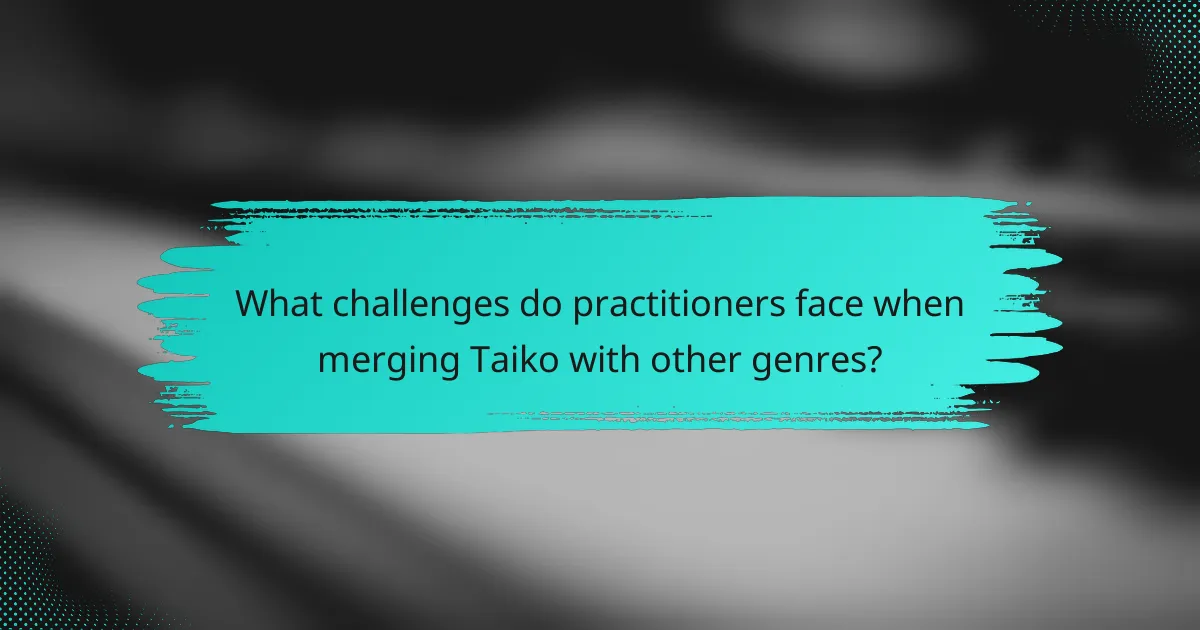
What challenges do practitioners face when merging Taiko with other genres?
Practitioners face several challenges when merging Taiko with other genres. These include cultural differences, rhythmic complexities, and instrumentation compatibility.
Cultural differences can create misunderstandings about Taiko’s traditional significance. Rhythmic complexities of Taiko may clash with the structures of other genres, making fusion difficult. Instrumentation compatibility is another challenge, as Taiko drums have unique sounds that may not blend easily with instruments from different genres.
Additionally, there may be resistance from purists who prefer traditional Taiko. This can hinder experimentation and innovation within collaborative efforts. Addressing these challenges requires open communication and a willingness to adapt techniques and styles.
How can cultural appropriation be navigated in musical fusion?
Cultural appropriation in musical fusion can be navigated by fostering respect and understanding. Musicians should engage with the cultural roots of Taiko drumming, recognizing its significance in Japanese heritage. Collaboration with cultural custodians ensures authenticity and appreciation. Educating audiences about the origins of the music promotes sensitivity. Additionally, blending Taiko techniques with Dutch genres can create innovative sounds while honoring traditional practices.
What are the common misconceptions about Taiko drumming in Western contexts?
Taiko drumming is often misunderstood in Western contexts, leading to several misconceptions. One common belief is that taiko is solely a performance art. In reality, it encompasses a rich cultural heritage and community involvement. Another misconception is that all taiko drumming is loud and aggressive; however, it includes a variety of styles, some of which emphasize subtlety and rhythm. Additionally, many people think taiko drumming is exclusively Japanese, but it has successfully fused with various genres, including Dutch music, creating unique collaborations. Lastly, some assume that taiko drumming is easy to learn, while mastering techniques requires significant dedication and practice.
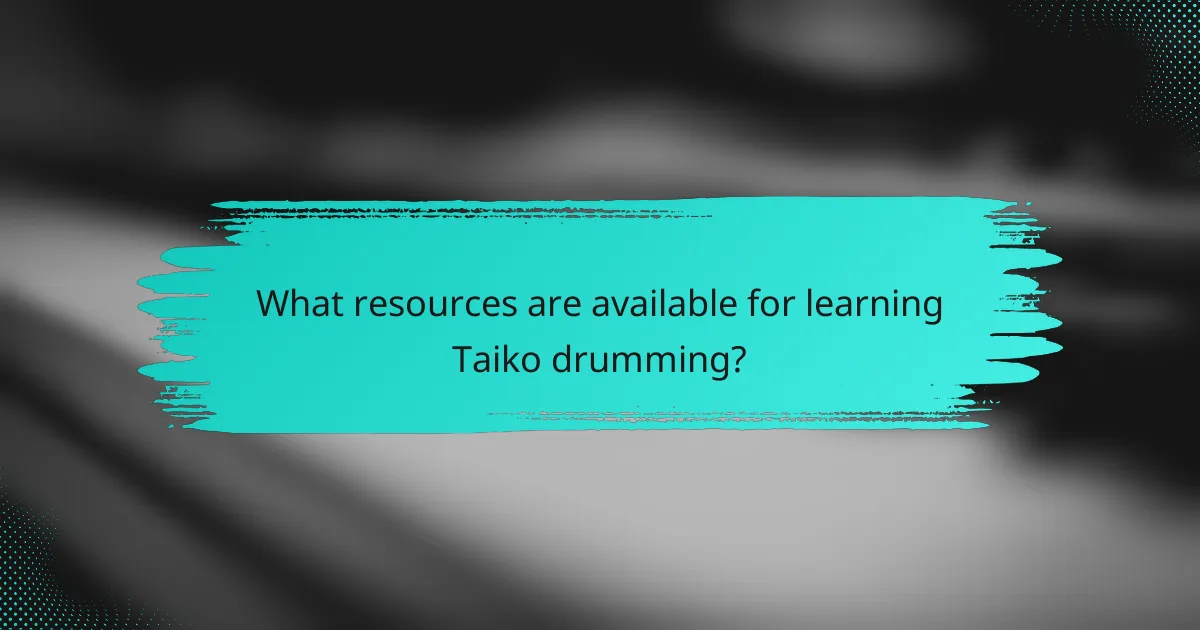
What resources are available for learning Taiko drumming?
Numerous resources exist for learning Taiko drumming, including online courses, local workshops, and instructional books. Websites like YouTube offer tutorials, while organizations such as the Taiko Community Alliance provide workshops and events. Books by authors like David Kawika Eyre offer insights into techniques and cultural significance. Local community centers often host classes, fostering connection through this unique art form.
Which online platforms offer Taiko drumming courses?
Several online platforms offer Taiko drumming courses, including Udemy, Skillshare, and YouTube. These platforms provide a variety of instructional videos and classes catering to different skill levels. For example, Udemy features structured courses with comprehensive lessons, while YouTube offers free tutorials and performances. Skillshare combines both video lessons and community engagement for a more interactive learning experience.
What are the best practices for practicing Taiko drumming at home?
To practice Taiko drumming at home effectively, focus on technique, consistency, and cultural appreciation. Start with a proper stance and grip to ensure control. Regularly practice basic rhythms to build muscle memory. Incorporate traditional pieces to understand the cultural significance. Use online resources for guidance and join virtual communities for support.
What common mistakes should beginners avoid in Taiko drumming?
Beginners in Taiko drumming should avoid neglecting proper posture, skipping warm-ups, overplaying, and ignoring rhythm. Maintaining correct posture prevents injuries and enhances performance. Warm-ups prepare muscles and improve flexibility. Overplaying can lead to fatigue and loss of technique. Lastly, focusing on rhythm is crucial for cohesive playing.
